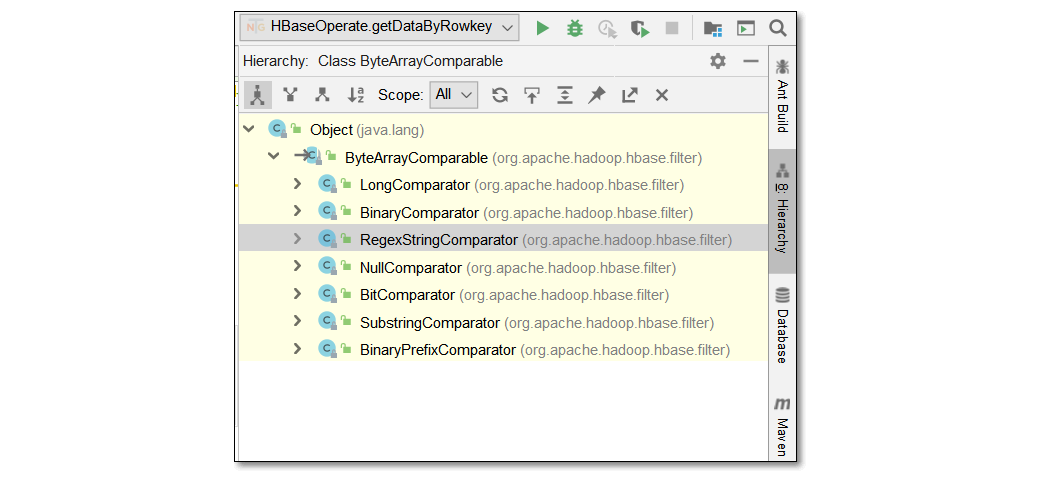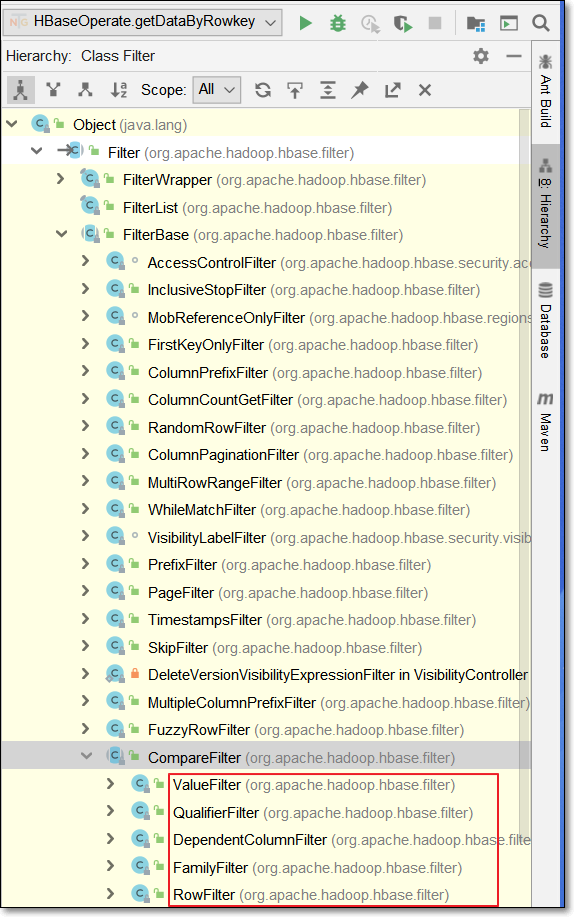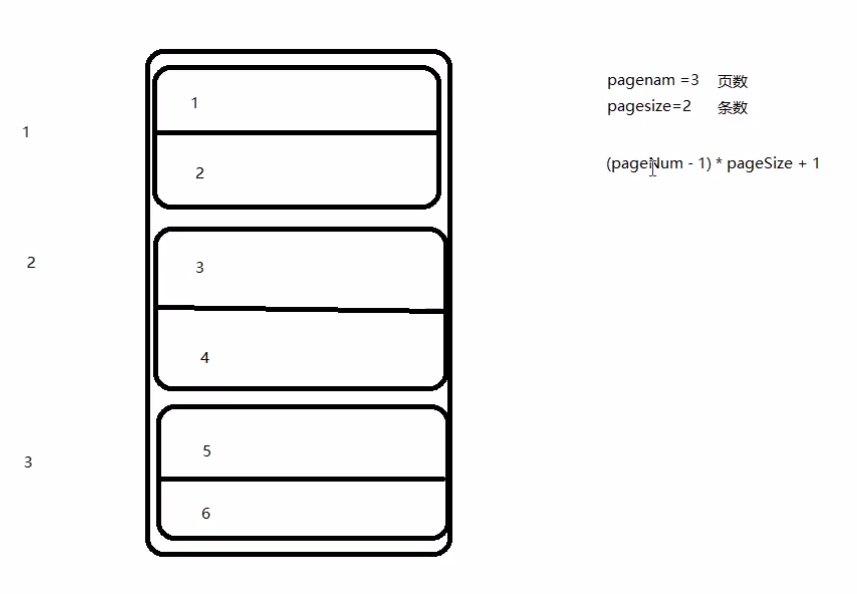HBase的JavaAPI操作
- HBase是一个分布式的NoSql数据库,在实际工作当中,我们一般都可以通过JavaAPI来进行各种数据的操作,包括创建表,以及数据的增删改查等等
创建maven工程
- 讲如下内容作为maven工程中pom.xml的repositories的内容
- 自动导包
|
1 2 3 4 5 6 7 8 9 10 11 12 13 14 15 16 17 18 19 20 21 22 23 24 25 26 27 28 29 30 31 32 33 34 35 36 37 38 39 40 41 42 43 44 45 46 47 48 49 50 51 52 53 54 55 56 57 58 59 60 61 62 63 64 65 66 67 68 69 70 71 72 73 74 75 76 77 78 79 80 81 82 83 84 85 86 87 88 89 90 91 92 93 94 |
<?xml version="1.0" encoding="UTF-8"?> <project xmlns="http://maven.apache.org/POM/4.0.0" xmlns:xsi="http://www.w3.org/2001/XMLSchema-instance" xsi:schemaLocation="http://maven.apache.org/POM/4.0.0 http://maven.apache.org/xsd/maven-4.0.0.xsd"> <parent> <artifactId>XZK</artifactId> <groupId>org.example</groupId> <version>1.0-SNAPSHOT</version> </parent> <modelVersion>4.0.0</modelVersion> <artifactId>HbaseApi1</artifactId> <dependencies> <dependency> <groupId>org.apache.hadoop</groupId> <artifactId>hadoop-client</artifactId> <version>3.1.4</version> </dependency> <dependency> <groupId>org.apache.hadoop</groupId> <artifactId>hadoop-auth</artifactId> <version>3.1.4</version> </dependency> <!-- https://mvnrepository.com/artifact/org.apache.hbase/hbase-client --> <dependency> <groupId>org.apache.hbase</groupId> <artifactId>hbase-client</artifactId> <version>2.2.6</version> </dependency> <dependency> <groupId>org.apache.hbase</groupId> <artifactId>hbase-server</artifactId> <version>2.2.6</version> </dependency> <dependency> <groupId>junit</groupId> <artifactId>junit</artifactId> <version>4.12</version> <scope>test</scope> </dependency> <dependency> <groupId>org.testng</groupId> <artifactId>testng</artifactId> <version>6.14.3</version> <scope>test</scope> </dependency> <dependency> <groupId>org.testng</groupId> <artifactId>testng</artifactId> <version>6.14.3</version> <scope>compile</scope> </dependency> </dependencies> <build> <plugins> <plugin> <groupId>org.apache.maven.plugins</groupId> <artifactId>maven-compiler-plugin</artifactId> <version>3.0</version> <configuration> <source>1.8</source> <target>1.8</target> <encoding>UTF-8</encoding> </configuration> </plugin> <plugin> <groupId>org.apache.maven.plugins</groupId> <artifactId>maven-shade-plugin</artifactId> <version>2.2</version> <executions> <execution> <phase>package</phase> <goals> <goal>shade</goal> </goals> <configuration> <filters> <filter> <artifact>*:*</artifact> <excludes> <exclude>META-INF/*.SF</exclude> <exclude>META-INF/*.DSA</exclude> <exclude>META-INF/*/RSA</exclude> </excludes> </filter> </filters> </configuration> </execution> </executions> </plugin> </plugins> </build> </project> |
创建myuser表
- 创建myuser表,此表有两个列族f1和f2
|
1 2 3 4 5 6 7 8 9 10 11 12 13 14 15 16 17 18 19 20 21 22 23 24 25 26 27 |
//操作数据库 第一步:获取连接 第二步:获取客户端对象 第三步:操作数据库 第四步:关闭 /** * 创建一张表 myuser 两个列族 f1 f2 */ @Test public void createTable() throws IOException { Configuration configuration = HBaseConfiguration.create(); //连接HBase集群不需要指定HBase主节点的ip地址和端口号 configuration.set("hbase.zookeeper.quorum","hadoop100:2181,hadoop101:2181,hadoop102:2181"); //创建连接对象 Connection connection = ConnectionFactory.createConnection(configuration); //获取连接对象,创建一张表 //获取管理员对象,来对手数据库进行DDL的操作 Admin admin = connection.getAdmin(); //指定我们的表名 TableName myuser = TableName.valueOf("myuser"); HTableDescriptor hTableDescriptor = new HTableDescriptor(myuser); //指定两个列族 HColumnDescriptor f1 = new HColumnDescriptor("f1"); HColumnDescriptor f2 = new HColumnDescriptor("f2"); hTableDescriptor.addFamily(f1); hTableDescriptor.addFamily(f2); admin.createTable(hTableDescriptor); admin.close(); connection.close(); } |
向表中添加数据
|
1 2 3 4 5 6 7 8 9 10 11 12 13 14 15 16 17 18 19 20 21 22 23 24 25 26 27 28 29 30 31 32 33 |
private Connection connection ; private final String TABLE_NAME = "myuser"; private Table table ; @Before public void initTable () throws IOException { Configuration configuration = HBaseConfiguration.create(); configuration.set("hbase.zookeeper.quorum","hadoop100:2181,hadoop101:2181"); connection = ConnectionFactory.createConnection(configuration); table = connection.getTable(TableName.valueOf(TABLE_NAME)); } @After public void close() throws IOException { table.close(); connection.close(); } /** * 向myuser表当中添加数据 */ @Test public void addData() throws IOException { //获取表 //Table table = connection.getTable(TableName.valueOf(TABLE_NAME)); Put put = new Put("0001".getBytes());//创建put对象,并指定rowkey值 put.addColumn("f1".getBytes(),"name".getBytes(),"zhangsan".getBytes()); put.addColumn("f1".getBytes(),"age".getBytes(), Bytes.toBytes(18)); put.addColumn("f1".getBytes(),"id".getBytes(), Bytes.toBytes(25)); put.addColumn("f1".getBytes(),"address".getBytes(), Bytes.toBytes("地球人")); table.put(put); table.close(); } |
查询数据
- 初始化一批数据到HBase表当中,用于查询

|
1 2 3 4 5 6 7 8 9 10 11 12 13 14 15 16 17 18 19 20 21 22 23 24 25 26 27 28 29 30 31 32 33 34 35 36 37 38 39 40 41 42 43 44 45 46 47 48 49 50 51 52 53 54 55 56 57 58 59 60 61 62 63 64 65 66 67 68 69 70 71 |
/** * hbase的批量插入数据 */ @Test public void batchInsert() throws IOException { // 创建put对象,并指定rowkey Put put = new Put("0002".getBytes()); put.addColumn("f1".getBytes(),"id".getBytes(),Bytes.toBytes(1)); put.addColumn("f1".getBytes(),"name".getBytes(),Bytes.toBytes("曹操")); put.addColumn("f1".getBytes(),"age".getBytes(),Bytes.toBytes(30)); put.addColumn("f2".getBytes(),"sex".getBytes(),Bytes.toBytes("1")); put.addColumn("f2".getBytes(),"address".getBytes(),Bytes.toBytes("沛国谯县")); put.addColumn("f2".getBytes(),"phone".getBytes(),Bytes.toBytes("16888888888")); put.addColumn("f2".getBytes(),"say".getBytes(),Bytes.toBytes("helloworld")); Put put2 = new Put("0003".getBytes()); put2.addColumn("f1".getBytes(),"id".getBytes(),Bytes.toBytes(2)); put2.addColumn("f1".getBytes(),"name".getBytes(),Bytes.toBytes("刘备")); put2.addColumn("f1".getBytes(),"age".getBytes(),Bytes.toBytes(32)); put2.addColumn("f2".getBytes(),"sex".getBytes(),Bytes.toBytes("1")); put2.addColumn("f2".getBytes(),"address".getBytes(),Bytes.toBytes("幽州涿郡涿县")); put2.addColumn("f2".getBytes(),"phone".getBytes(),Bytes.toBytes("17888888888")); put2.addColumn("f2".getBytes(),"say".getBytes(),Bytes.toBytes("talk is cheap , show me the code")); Put put3 = new Put("0004".getBytes()); put3.addColumn("f1".getBytes(),"id".getBytes(),Bytes.toBytes(3)); put3.addColumn("f1".getBytes(),"name".getBytes(),Bytes.toBytes("孙权")); put3.addColumn("f1".getBytes(),"age".getBytes(),Bytes.toBytes(35)); put3.addColumn("f2".getBytes(),"sex".getBytes(),Bytes.toBytes("1")); put3.addColumn("f2".getBytes(),"address".getBytes(),Bytes.toBytes("下邳")); put3.addColumn("f2".getBytes(),"phone".getBytes(),Bytes.toBytes("12888888888")); put3.addColumn("f2".getBytes(),"say".getBytes(),Bytes.toBytes("what are you 弄啥嘞!")); Put put4 = new Put("0005".getBytes()); put4.addColumn("f1".getBytes(),"id".getBytes(),Bytes.toBytes(4)); put4.addColumn("f1".getBytes(),"name".getBytes(),Bytes.toBytes("诸葛亮")); put4.addColumn("f1".getBytes(),"age".getBytes(),Bytes.toBytes(28)); put4.addColumn("f2".getBytes(),"sex".getBytes(),Bytes.toBytes("1")); put4.addColumn("f2".getBytes(),"address".getBytes(),Bytes.toBytes("四川隆中")); put4.addColumn("f2".getBytes(),"phone".getBytes(),Bytes.toBytes("14888888888")); put4.addColumn("f2".getBytes(),"say".getBytes(),Bytes.toBytes("出师表你背了嘛")); Put put5 = new Put("0006".getBytes()); put5.addColumn("f1".getBytes(),"id".getBytes(),Bytes.toBytes(5)); put5.addColumn("f1".getBytes(),"name".getBytes(),Bytes.toBytes("司马懿")); put5.addColumn("f1".getBytes(),"age".getBytes(),Bytes.toBytes(27)); put5.addColumn("f2".getBytes(),"sex".getBytes(),Bytes.toBytes("1")); put5.addColumn("f2".getBytes(),"address".getBytes(),Bytes.toBytes("哪里人有待考究")); put5.addColumn("f2".getBytes(),"phone".getBytes(),Bytes.toBytes("15888888888")); put5.addColumn("f2".getBytes(),"say".getBytes(),Bytes.toBytes("跟诸葛亮死掐")); Put put6 = new Put("0007".getBytes()); put6.addColumn("f1".getBytes(),"id".getBytes(),Bytes.toBytes(5)); put6.addColumn("f1".getBytes(),"name".getBytes(),Bytes.toBytes("xiaobubu—吕布")); put6.addColumn("f1".getBytes(),"age".getBytes(),Bytes.toBytes(28)); put6.addColumn("f2".getBytes(),"sex".getBytes(),Bytes.toBytes("1")); put6.addColumn("f2".getBytes(),"address".getBytes(),Bytes.toBytes("内蒙人")); put6.addColumn("f2".getBytes(),"phone".getBytes(),Bytes.toBytes("15788888888")); put6.addColumn("f2".getBytes(),"say".getBytes(),Bytes.toBytes("貂蝉去哪了")); List<Put> listPut = new ArrayList<Put>(); listPut.add(put); listPut.add(put2); listPut.add(put3); listPut.add(put4); listPut.add(put5); listPut.add(put6); table.put(listPut); } |
Get查询
- 按照rowkey进行查询,获取所有列的所有值
- 查询主键rowkey为0003的人
|
1 2 3 4 5 6 7 8 9 10 11 12 13 14 15 16 17 18 19 20 21 22 23 24 25 26 27 28 29 30 31 32 33 34 35 36 37 38 39 40 41 42 |
/** * 查询rowkey为0003的人 * get -> Result */ @Test public void getData() throws IOException { // Table table = connection.getTable(TableName.valueOf(TABLE_NAME)); // 通过get对象,指定rowkey Get get = new Get(Bytes.toBytes("0001")); get.addFamily("f1".getBytes());//限制只查询f1列族下面所有列的值 // 查询f2 列族 phone 这个字段 get.addColumn("f2".getBytes(), "phone".getBytes()); // 通过get查询,返回一个result对象,所有的字段的数据都是封装在result里面了 Result result = table.get(get); List<Cell> cells = result.listCells(); //获取一条数据所有的cell,所有数据值都是在cell里面 的 if (cells != null) { for (Cell cell : cells) { // 获取列族名 byte[] familyName = CellUtil.cloneFamily(cell); // 获取列名 byte[] columnName = CellUtil.cloneQualifier(cell); // 获取rowKey byte[] rowKey = CellUtil.cloneRow(cell); // 获取cell值 byte[] cellValue = CellUtil.cloneValue(cell); // 需要判断字段的数据类型,使用对应的转换的方法,才能够获取到值 if ("age".equals(Bytes.toString(columnName)) || "id".equals(Bytes.toString(columnName))) { System.out.println(Bytes.toString(familyName)); System.out.println(Bytes.toString(columnName)); System.out.println(Bytes.toString(rowKey)); System.out.println(Bytes.toInt(cellValue)); } else { System.out.println(Bytes.toString(familyName)); System.out.println(Bytes.toString(columnName)); System.out.println(Bytes.toString(rowKey)); System.out.println(Bytes.toString(cellValue)); } } table.close(); } } |
Scan查询
|
1 2 3 4 5 6 7 8 9 10 11 12 13 14 15 16 17 18 19 20 21 22 23 24 25 26 27 28 29 30 31 32 33 34 35 36 |
/** * 不知道rowkey的具体值,我想查询rowkey范围值是0003 到0006 * select * from myuser where age > 30 and id < 8 and name like 'zhangsan' * */ @Test public void scanData() throws IOException { // 获取table // Table table = connection.getTable(TableName.valueOf(TABLE_NAME)); Scan scan = new Scan();// 没有指定startRow以及stopRow 全表扫描 // 只扫描f1列族 scan.addFamily("f1".getBytes()); // 只扫描f2列族: phone 这个字段 scan.addColumn("f2".getBytes(), "phone".getBytes()); scan.withStartRow("0003".getBytes()); scan.withStopRow("0007".getBytes()); // 前闭后开 // 通过getScanner查询获取到了表里面所有的数据,是多条数据 ResultScanner scanner = table.getScanner(scan); // 遍历ResultScanner 得到每一条数据,每一条数据都是封装在result对象里面了 for (Result result : scanner) { List<Cell> cells = result.listCells(); for (Cell cell : cells) { byte[] family_name = CellUtil.cloneFamily(cell); byte[] qualifier_name = CellUtil.cloneQualifier(cell); byte[] rowkey = CellUtil.cloneRow(cell); byte[] value = CellUtil.cloneValue(cell); //判断id和age字段,这两个字段是整形值 if ("age".equals(Bytes.toString(qualifier_name)) || "id".equals(Bytes.toString(qualifier_name))) { System.out.println("数据的rowkey为" + Bytes.toString(rowkey) + "======数据的列族为" + Bytes.toString(family_name) + "======数据的列名为" + Bytes.toString(qualifier_name) + "==========数据的值为" + Bytes.toInt(value)); } else { System.out.println("数据的rowkey为" + Bytes.toString(rowkey) + "======数据的列族为" + Bytes.toString(family_name) + "======数据的列名为" + Bytes.toString(qualifier_name) + "==========数据的值为" + Bytes.toString(value)); } } } table.close(); } |
HBase过滤器查询
过滤器
-
过滤器的作用是在服务端判断数据是否满足条件,然后只将满足条件的数据返回给客户端
-
过滤器的类型很多,但是可以分为两大类
- ==比较过滤器==
- ==专用过滤器==
比较过滤器使用
- HBase过滤器的比较运算符:
|
1 2 3 4 5 6 7 |
LESS < LESS_OR_EQUAL <= EQUAL = NOT_EQUAL <> 不等于 GREATER_OR_EQUAL >= GREATER > NO_OP 排除所有 |
- HBase比较过滤器的比较器(指定比较机制):
|
1 2 3 4 5 6 |
BinaryComparator 按字节索引顺序比较指定字节数组,采用Bytes.compareTo(byte[]) BinaryPrefixComparator 跟前面相同,只是比较左端前缀的数据是否相同 NullComparator 判断给定的是否为空 BitComparator 按位比较 RegexStringComparator 提供一个正则的比较器,仅支持 EQUAL 和非EQUAL SubstringComparator 判断提供的子串是否出现在中 |

- 比较过滤器

1、rowKey过滤器RowFilter
- 通过RowFilter过滤比rowKey 0003小的所有值出来
|
1 2 3 4 5 6 7 8 9 10 11 12 13 14 15 16 17 18 19 20 21 22 23 24 25 26 27 28 29 30 31 32 33 34 |
/** * 查询所有的rowkey比0003小的所有的数据 */ @Test public void rowFilter() throws IOException { // Table table = connection.getTable(TableName.valueOf(TABLE_NAME)); Scan scan = new Scan(); // 获取我们比较对象 BinaryComparator binaryComparator = new BinaryComparator("0003".getBytes()); /* * rowFilter需要加上两个参数 * 第一个参数就是我们的比较规则 * 第二个参数就是我们的比较对象 */ RowFilter rowFilter = new RowFilter(CompareFilter.CompareOp.LESS, binaryComparator); // 为我们的scan对象设置过滤器 scan.setFilter(rowFilter); ResultScanner scanner = table.getScanner(scan); for (Result result : scanner) { List<Cell> cells = result.listCells(); for (Cell cell : cells) { byte[] family_name = CellUtil.cloneFamily(cell); byte[] qualifier_name = CellUtil.cloneQualifier(cell); byte[] rowkey = CellUtil.cloneRow(cell); byte[] value = CellUtil.cloneValue(cell); // 判断id和age字段,这两个字段是整形值 if ("age".equals(Bytes.toString(qualifier_name)) || "id".equals(Bytes.toString(qualifier_name))) { System.out.println("数据的rowkey为" + Bytes.toString(rowkey) + "======数据的列族为" + Bytes.toString(family_name) + "======数据的列名为" + Bytes.toString(qualifier_name) + "==========数据的值为" + Bytes.toInt(value)); } else { System.out.println("数据的rowkey为" + Bytes.toString(rowkey) + "======数据的列族为" + Bytes.toString(family_name) + "======数据的列名为" + Bytes.toString(qualifier_name) + "==========数据的值为" + Bytes.toString(value)); } } } } |
2、列族过滤器FamilyFilter
- 查询列族名包含f2的所有列族下面的数据
|
1 2 3 4 5 6 7 8 9 10 11 12 13 14 15 16 17 18 19 20 21 22 23 24 25 26 27 28 29 30 |
/** * 通过familyFilter来实现列族的过滤 * 需要过滤,列族名包含f2 * f1 f2 hello world */ @Test public void familyFilter() throws IOException { // Table table = connection.getTable(TableName.valueOf(TABLE_NAME)); Scan scan = new Scan(); SubstringComparator substringComparator = new SubstringComparator("f2"); // 通过familyfilter来设置列族的过滤器 FamilyFilter familyFilter = new FamilyFilter(CompareFilter.CompareOp.EQUAL, substringComparator); scan.setFilter(familyFilter); ResultScanner scanner = table.getScanner(scan); for (Result result : scanner) { List<Cell> cells = result.listCells(); for (Cell cell : cells) { byte[] familyName = CellUtil.cloneFamily(cell); byte[] qualifierName = CellUtil.cloneQualifier(cell); byte[] rowKey = CellUtil.cloneRow(cell); byte[] value = CellUtil.cloneValue(cell); // 判断id和age字段,这两个字段是整形值 if ("age".equals(Bytes.toString(qualifierName)) || "id".equals(Bytes.toString(qualifierName))) { System.out.println("数据的rowkey为" + Bytes.toString(rowKey) + "======数据的列族为" + Bytes.toString(familyName) + "======数据的列名为" + Bytes.toString(qualifierName) + "==========数据的值为" + Bytes.toInt(value)); } else { System.out.println("数据的rowkey为" + Bytes.toString(rowKey) + "======数据的列族为" + Bytes.toString(familyName) + "======数据的列名为" + Bytes.toString(qualifierName) + "==========数据的值为" + Bytes.toString(value)); } } } } |
3、列过滤器QualifierFilter
- 只查询列名包含
name的列的值
|
1 2 3 4 5 6 7 8 9 10 11 12 13 14 15 16 17 18 19 20 21 22 23 24 25 26 27 28 29 30 |
/** * 列名过滤器 只查询包含name列的值 */ @Test public void qualifierFilter() throws IOException { Scan scan = new Scan(); SubstringComparator substringComparator = new SubstringComparator("name"); // 定义列名过滤器,只查询列名包含name的列 QualifierFilter qualifierFilter = new QualifierFilter(CompareFilter.CompareOp.EQUAL, substringComparator); scan.setFilter(qualifierFilter); ResultScanner scanner = table.getScanner(scan); printResult(scanner); } public void printResult(ResultScanner scanner) { for (Result result : scanner) { List<Cell> cells = result.listCells(); for (Cell cell : cells) { byte[] family_name = CellUtil.cloneFamily(cell); byte[] qualifier_name = CellUtil.cloneQualifier(cell); byte[] rowkey = CellUtil.cloneRow(cell); byte[] value = CellUtil.cloneValue(cell); //判断id和age字段,这两个字段是数值 if("age".equals(Bytes.toString(qualifier_name)) || "id".equals(Bytes.toString(qualifier_name))){ System.out.println("rowkey: " + Bytes.toString(rowkey) + ";列族: " + Bytes.toString(family_name) + ";列名: " + Bytes.toString(qualifier_name) + ";数据: " + Bytes.toInt(value)); }else{ System.out.println("rowkey: " + Bytes.toString(rowkey) + ";列族: " + Bytes.toString(family_name) + ";列名: " + Bytes.toString(qualifier_name) + ";数据: " + Bytes.toString(value)); } } } } |
4、列值过滤器ValueFilter
- 查询所有列当中包含8的数据
|
1 2 3 4 5 6 7 8 9 10 11 12 13 |
/** * 查询哪些字段值 包含数字8 */ @Test public void contains8() throws IOException { Scan scan = new Scan(); SubstringComparator substringComparator = new SubstringComparator("8"); // 列值过滤器,过滤列值当中包含数字8的所有的列 ValueFilter valueFilter = new ValueFilter(CompareFilter.CompareOp.EQUAL, substringComparator); scan.setFilter(valueFilter); ResultScanner scanner = table.getScanner(scan); printResult(scanner); } |
专用过滤器使用
1、单列值过滤器 SingleColumnValueFilter
-
SingleColumnValueFilter会返回满足条件的cell。所在行的所有cell的值
-
查询f1 列族 name 列 值为刘备的数据
|
1 2 3 4 5 6 7 8 9 10 11 12 |
/** */ @Test public void singleColumnValueFilter() throws IOException { // 查询 f1 列族 name 列 值为刘备的数据 Scan scan = new Scan(); // 单列值过滤器,过滤 f1 列族 name 列 值为刘备的数据 SingleColumnValueFilter singleColumnValueFilter = new SingleColumnValueFilter("f1".getBytes(), "name".getBytes(), CompareFilter.CompareOp.EQUAL, "刘备".getBytes()); scan.setFilter(singleColumnValueFilter); ResultScanner scanner = table.getScanner(scan); printResult(scanner); } |
2、列值排除过滤器SingleColumnValueExcludeFilter
- 与SingleColumnValueFilter相反
- 如果指定列的值符合filter条件,则会排除掉row中指定的列,其他的列全部返回
- 如果列不存在或不符合filter条件,则不返回row中的列
3、rowkey前缀过滤器PrefixFilter
- 查询以00开头的所有前缀的rowkey
|
1 2 3 4 5 6 7 8 9 10 11 12 |
/** * 查询rowkey前缀以 00开头的所有的数据 */ @Test public void prefixFilter() throws IOException { Scan scan = new Scan(); //过滤rowkey以 00开头的数据 PrefixFilter prefixFilter = new PrefixFilter("00".getBytes()); scan.setFilter(prefixFilter); ResultScanner scanner = table.getScanner(scan); printResult(scanner); } |
4、分页过滤器PageFilter
- 通过pageFilter实现分页过滤器
|
1 2 3 4 5 6 7 8 9 10 11 12 13 14 15 16 17 18 19 20 21 22 23 24 25 26 27 28 29 30 |
/** * HBase当中的分页 */ @Test public void hbasePageFilter() throws IOException { int pageNum = 3; int pageSize = 2; Scan scan = new Scan(); String startRow = ""; // 扫描数据的调试 扫描五条数据 int scanDatas = (pageNum - 1) * pageSize + 1; scan.setMaxResultSize(scanDatas);//设置一步往前扫描多少条数据 PageFilter filter = new PageFilter(scanDatas); scan.setFilter(filter); ResultScanner scanner = table.getScanner(scan); for (Result result : scanner) { // 获取rowkey byte[] row = result.getRow(); // 最后一次startRow的值就是0005 startRow = Bytes.toString(row);// 循环遍历我们所有获取到的数据的rowkey // 最后一条数据的rowkey就是我们需要的起始的rowkey } // 获取第三页的数据 scan.withStartRow(startRow.getBytes()); scan.setMaxResultSize(pageSize);//设置我们扫描多少条数据 PageFilter filter1 = new PageFilter(pageSize); scan.setFilter(filter1); ResultScanner scanner1 = table.getScanner(scan); printResult(scanner1); } |
说明:
pageSize = 2设置每页展示2条数据pageNum = 3设置查询第3页数据- 计算查询首条记录的索引
(pageNum - 1) * pageSize + 1

5、多过滤器综合查询FilterList
- 需求:使用
SingleColumnValueFilter查询f1列族,name为刘备的数据,并且同时满足rowkey的前缀以00开头的数据(PrefixFilter)
|
1 2 3 4 5 6 7 8 9 10 11 12 13 14 15 16 |
/** * 查询 f1 列族 name 为刘备数据值 * 并且rowkey 前缀以 00开头数据 */ @Test public void filterList() throws IOException { Scan scan = new Scan(); SingleColumnValueFilter singleColumnValueFilter = new SingleColumnValueFilter("f1".getBytes(), "name".getBytes(), CompareFilter.CompareOp.EQUAL, "刘备".getBytes()); PrefixFilter prefixFilter = new PrefixFilter("00".getBytes()); FilterList filterList = new FilterList(); filterList.addFilter(singleColumnValueFilter); filterList.addFilter(prefixFilter); scan.setFilter(filterList); ResultScanner scanner = table.getScanner(scan); printResult(scanner); } |
说明:
SingleColumnValueFilter单列过滤器, 比较列值是否等于刘备prefixFilter前缀过滤器用于匹配rowKey是否以00开头
Views: 11

